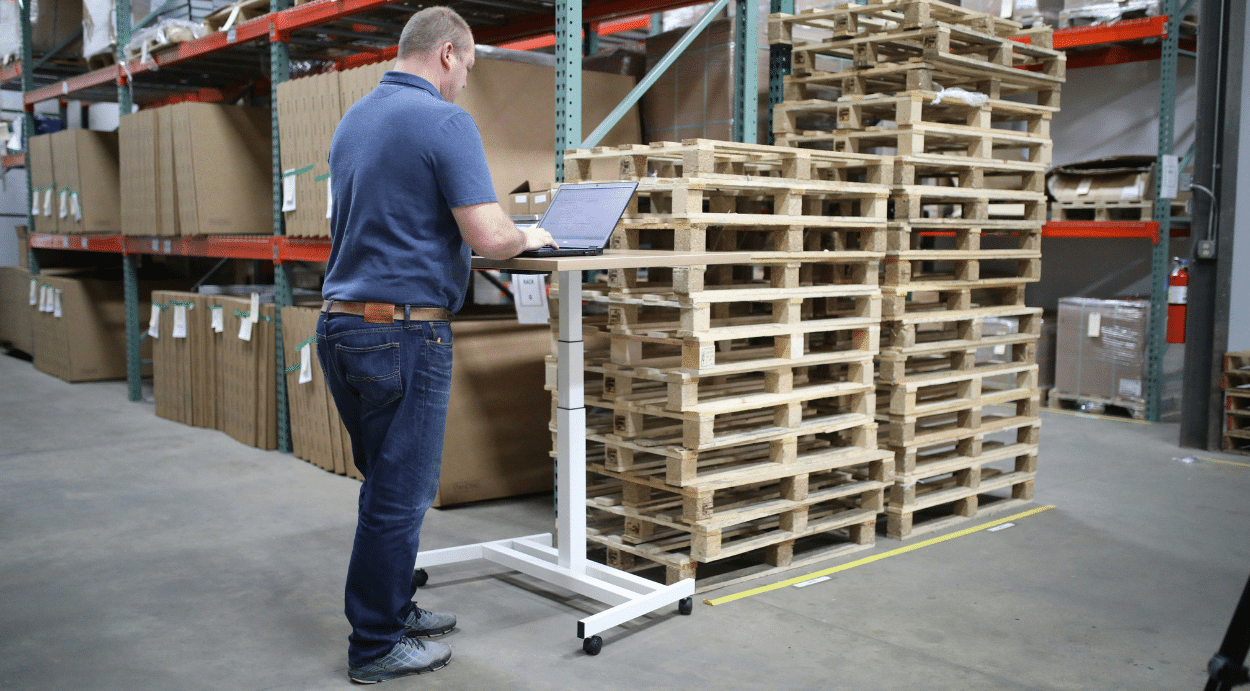Cycle counting is a method businesses use to keep inventory data accurate without shutting down operations for a full physical count. Instead of reviewing every item at once, companies check smaller sections of inventory on a rotating schedule. This spreads the work across the year and allows businesses to prioritize high-value items that need the closest attention. It also improves accuracy and helps to reveal inventory discrepancies faster.
What’s the Difference Between Cycle Counting and an Annual Physical Inventory Count?
When you use cycle counting for inventory, you count small portions of your products on a rotating basis. For example, a warehouse might count all high-value electronics every Monday, mid-range products once a month, and slow-moving goods once or twice a year. With cycle counting, over time, every item is checked without ever halting operations.
In contrast, an annual inventory counts everything at once, requiring operations to shut down while the count is performed. While a full physical inventory count is useful for audits or regulatory compliance, it can also be highly disruptive and resource-intensive.
What Are the Benefits of Cycle Counting Inventory?
Adopting a process of regularly scheduled inventory counts provides value in several ways:
- Improved Inventory Accuracy: Frequent checks mean fewer discrepancies between system records and actual stock levels.
- Reduced Disruption: Teams can continue shipping and fulfilling orders while counts are performed, minimizing the risk of delayed deliveries.
- Lower Costs: No large-scale shutdowns or overtime will be required, unlike with annual counts.
- Improved Customer Experience: Accurate inventory levels reduce backorders, cancellations, and delays.
- Better Forecasting: Having accurate data supports smarter purchasing and demand planning.
- Early Error Detection: Mistakes are caught more quickly, rather than potentially compounding over the course of up to a year until the next annual count.
How to Implement Cycle Counting
Businesses can choose from several approaches to cycle counting or combine them for a customized inventory strategy.
ABC Cycle Counting
One of the most widely used inventory cycle counting methods is the ABC model, which is based on the 80/20 rule, also known as the Pareto Principle. The 80/20 rule says that 80% of your inventory consumption will come from 20% of your inventory. With the ABC method, you divide your products into three groups, each of which is counted at different intervals.
- Group A: High-value and high-demand products, typically around 10% to 20% of total inventory but representing most of your sales. These are counted monthly or even weekly.
- Group B: Mid-range products, making up about 20% of your stock. These items are counted quarterly.
- Group C: Low-value or slow-moving items, often the majority of your inventory by volume but least important for revenue. Count these items once or twice a year.
This method directs inventory counting to where it matters most.
Random Sample Cycle Counting
This method involves picking a set of items at random to count. It’s especially useful in warehouses that stock a large number of very similar products. Random sampling can be done in two ways. Constant population sampling means selecting the same number of items each time from the entire inventory pool, which may result in some items being counted more than others. Diminished population counting removes items from the selection pool once they’re counted, ensuring that eventually, every product is counted.
Control Group Cycle Counting
Use this method of cycle counting if you need to establish a baseline for whether your counting process is effective. In this approach, a small set of products is chosen and then counted repeatedly over a short period. If repeated counts reveal inventory errors, managers know the issue lies with the process itself; perhaps staff need to be retrained, or maybe system integrations need to be improved. Once the problem is corrected, counting can then be expanded across the entire inventory.
How Often Should Cycle Counts Be Done?
The frequency of cycle counts can vary depending on factors including sales volume, item value, and company size. Typically, items will be counted daily, weekly, monthly, quarterly, or annually. The key is to ensure that every item is reviewed at least once a year, with additional attention given to the products that drive most of your revenue.
How Do You Do a Cycle Count?
- Select Items to Count: Use the ABC method, choose a random sample of products, or determine another approach that works best for your goals.
- Isolate the Stock: Pause transactions for these items to avoid changes mid-count.
- Physically Count Items: Using scanners, RFID, or manual tallies, count the actual inventory of each item.
- Compare With Inventory Records: Check your results against what’s in your inventory management system.
- Investigate Discrepancies: If any of the figures don’t match up, look for an explanation, such as mis-picks, theft, damage, or data entry errors.
- Adjust and Record: Update records and note corrective actions to prevent repeat issues.
Inventory Cycle Counting Best Practices
Cycle counting is most effective when treated as a routine, not a one-off task. Many warehouses build cycle counting procedures into daily or weekly operations so that different sections are reviewed continuously.
It’s important to assign trained staff to each cycle count job. At larger businesses, teams may split responsibilities; at smaller ones, a few employees may handle counts during quieter periods. Make sure to assign at least two people to verify the results.
Scheduling also matters. Counting inventory is best performed during low-activity windows, such as before operations begin in the morning or after they’ve closed for the day. And to maintain consistency, businesses should document procedures clearly so each count is done the same way.
Managers should monitor performance metrics like accuracy rates and shrinkage over time. This data reveals whether the inventory cycle count process is improving or if adjustments are needed.
Common Inventory Control Challenges and How to Overcome Them With Brightpearl
Even the best cycle counting processes can face hurdles, and complex schedules, multiple product categories, and high volumes of transactions can make it difficult to maintain inventory accuracy and consistency. Brightpearl by Sage addresses these challenges by:
- Automating stock updates across multiple sales channels in real time, so physical counts can be quickly reconciled with system records
- Highlighting inventory discrepancies between expected and actual counts, helping businesses to identify shrinkage, mis-picks, or data entry errors immediately
- Providing strategic insights and reporting, allowing businesses to prioritize high-value or high-volume SKUs for more frequent checks
By integrating a cycle counting program with Brightpearl, retailers can streamline the process, maintain higher stock accuracy, and prevent stockouts or overselling, all without interrupting day-to-day operations. Built-in analytics also make it easy to monitor trends, identify potential issues early, and continuously improve your inventory management strategy. Book a demo today to see how Brightpearl can make managing your inventory easier.
Frequently Asked Questions
Do I Need to Stop Operations to Do a Cycle Count?
No. Cycle counting is done in small sections, so warehouse or retail operations can continue without interruption.
How Do I Decide Which Items to Count Most Frequently?
Use the ABC counting method: High-value or high-demand items should be counted more often. Brightpearl can automate this prioritization for you, highlighting which SKUs need attention.
Can Cycle Counting Replace a Full Annual Inventory?
Cycle counting reduces the need for full physical counts, but some businesses still perform annual inventories for audits or regulatory purposes.
What if My Team Finds Repeated Discrepancies During a Count?
Repeated discrepancies usually indicate a process or system issue. Investigate the root cause (such as staff training gaps, mislabeling, or system errors), and adjust your warehouse management procedures accordingly.
How Can Technology Improve Cycle Counting Accuracy?
Inventory management platforms like Brightpearl automate scheduling, sync stock across channels, track discrepancies, and generate audit-ready reports, reducing the potential for introducing human error.
How Long Does it Take to Implement a Cycle Counting Process?
The timeline depends on inventory size, complexity, and resources. Counting inventory starting with high-priority items by using an ABC analysis can show results quickly, with full cycle count implementation scaling up over time.
Is Cycle Counting Suitable for Small Businesses?
Yes. Even small inventories benefit from regular counts, and Brightpearl makes this process manageable without a dedicated full-time team.
How Does Cycle Counting Support Audit Compliance?
Regular counts create a clear, auditable record of inventory accuracy, and Brightpearl’s reporting makes it easy to demonstrate effective stock control to auditors.
Can Cycle Counting Integrate With Omnichannel Sales?
Yes. And Brightpearl can sync inventory across multiple channels, ensuring that your inventory counts reflect both online and offline stock.
What Metrics Should I Track for Cycle Counting Success?
Track inventory accuracy, discrepancies found per count, shrinkage, and the time spent on cycle counts. Monitoring these metrics helps to optimize the process over time.



